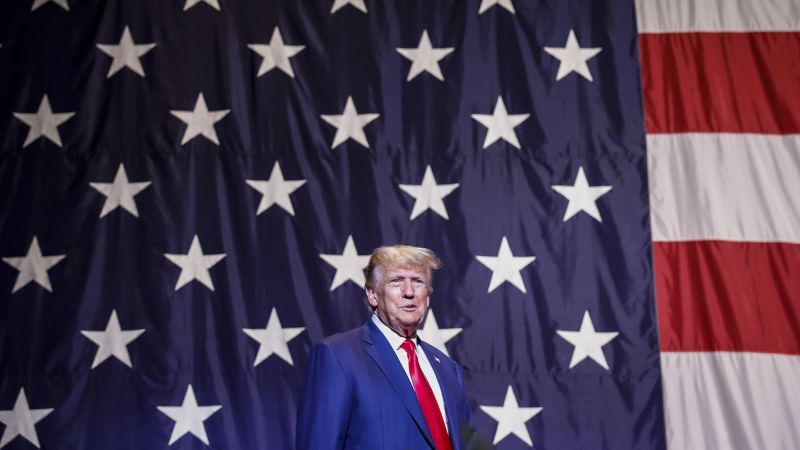The chance of Trump winning another term is very real

Donald Trump is facing two indictments, with the potential for more. Political wisdom may have once suggested the former president’s bid for a second White House term would be nothing but a pipe dream. But most of us know better by now.
Trump is not only in a historically strong position for a nonincumbent to win the Republican nomination, but he is in a better position to win the general election than at any point during the 2020 cycle and almost at any point during the 2016 cycle.
No one in Trump’s current polling position has lost an open presidential primary (i.e., one without an incumbent) in the modern era. He’s pulling in more than 50% of support in the national polls, which is more than all his competitors combined.
Three prior candidates in open primaries were pulling in more than half the vote in primary surveys in the second half of the calendar year before the election: Democrat Al Gore and Republican George W. Bush in 2000 and Democrat Hillary Clinton in 2016. Gore remains the only nonincumbent to win every single presidential nominating contest, while Bush and Clinton never lost their national polling advantage in their primaries.
Today, Trump’s closest primary competitor, Florida Gov. Ron DeSantis, has fallen below 20% nationally. No other contender is at or above 10%. This makes the margin between Trump and the rest of the field north of 30 points on average.
A look back at past polls does show candidates coming back from deficits greater than 10 points to win the nomination, but none greater than 30 points at this point. In fact, the biggest comebacks when you average all the polls in the second half of the year before the election top out at about 20 points (Democrats George McGovern in 1972, Jimmy Carter in 1976 and Barack Obama in 2008).
Obama did fall nearly 30 points behind for a brief period in the fall of 2007, though his comeback the following year and that of Republican John McCain (another eventual nominee who trailed by over 10 points nationally) points to another reason why Trump is so strong right now.
Trump is leading not just nationally but in the early-voting states as well. He’s up by double digits in Iowa, New Hampshire and South Carolina.
Obama was within single digits of Clinton and Iowa poll leader John Edwards at this point in the 2008 cycle. Similarly, Clinton’s edge was in the single digits over Obama in South Carolina at this stage of the campaign.
On the Republican side in 2008, the primary deck was much more unsettled than the national numbers indicated at this point. Rudy Giuliani was up nationally, but he lagged behind Mitt Romney in Iowa and New Hampshire. Romney couldn’t get much above 30% in either state, unlike Trump right now.
McCain (whose candidacy is often held up as an example of how DeSantis might come back) was always considerably closer to the national and state front-runners than anyone is to Trump at this moment.
Of course, winning the primary is one thing for Trump, who has led in almost every single Republican primary poll published in the past eight years.
What should arguably be more amazing is that despite most Americans agreeing that Trump’s two indictments thus far were warranted, he remains competitive in a potential rematch with President Joe Biden. A poll out last week from Marquette University Law School had Biden and Trump tied percentage-wise (with a statistically insignificant few more respondents choosing Trump).
The Marquette poll is one of a number of surveys showing Trump either tied or ahead of Biden. The ABC News/Washington Post poll has published three surveys of the matchup between the two, and Trump has come out ahead – albeit within the margin of error – every time. Other pollsters have shown Biden only narrowly ahead.
To put that in perspective, Trump never led in a single national poll that met CNN’s standards for publication for the entirety of the 2020 campaign. Biden was up by high single digits in the late summer of 2019. Biden is up by maybe a point in the average of all 2024 polls today.
Surveys in the late summer of 2015 told the same story: Clinton was up by double digits over Trump in late July and up by mid-to-high single digits by the end of August 2015.
The fact that the polling between Biden and Trump is so close shouldn’t be much of a surprise. Elections are a choice between two candidates. Trump isn’t popular, but neither is Biden. The two, in tandem, would be the most disliked presidential nominees in polling history, if their numbers hold through the election.
All that being said, the 2024 election will probably come down to a few swing states. Polling in swing states has been limited because we’re still over a year from the election.
One giant warning sign for Democrats was a late June Quinnipiac University poll from Pennsylvania, a pivotal state for the past few election cycles where Trump rallied base supporters in Erie on Saturday. The state barely voted for Trump in 2016 and for Biden in 2020.
Trump was up on Biden by 1 point in the Quinnipiac poll – a result within the margin of error, but nevertheless a remarkable achievement for the former president.
Why? It was only the second Pennsylvania poll that met CNN standards for publication since 2015 that had Trump ahead of either Biden (for 2020 and 2024) or Clinton (for 2016).
The good news for Democrats is that general election polling, unlike primary polling, is not predictive at this point. Things can most certainly change.
But for now, the chance that Trump is president in less than two years time is a very real possibility.











